Project Report: Banking and Finance - CBA, AMP, and Capital Budgeting
VerifiedAdded on 2023/06/04
|13
|3261
|281
Report
AI Summary
This report provides a detailed analysis of key concepts in banking and finance. It begins with an evaluation of the share performance of Commonwealth Bank of Australia (CBA) and AMP Limited, examining fluctuations and trends over the past five years, and discussing factors influencing their stoc...
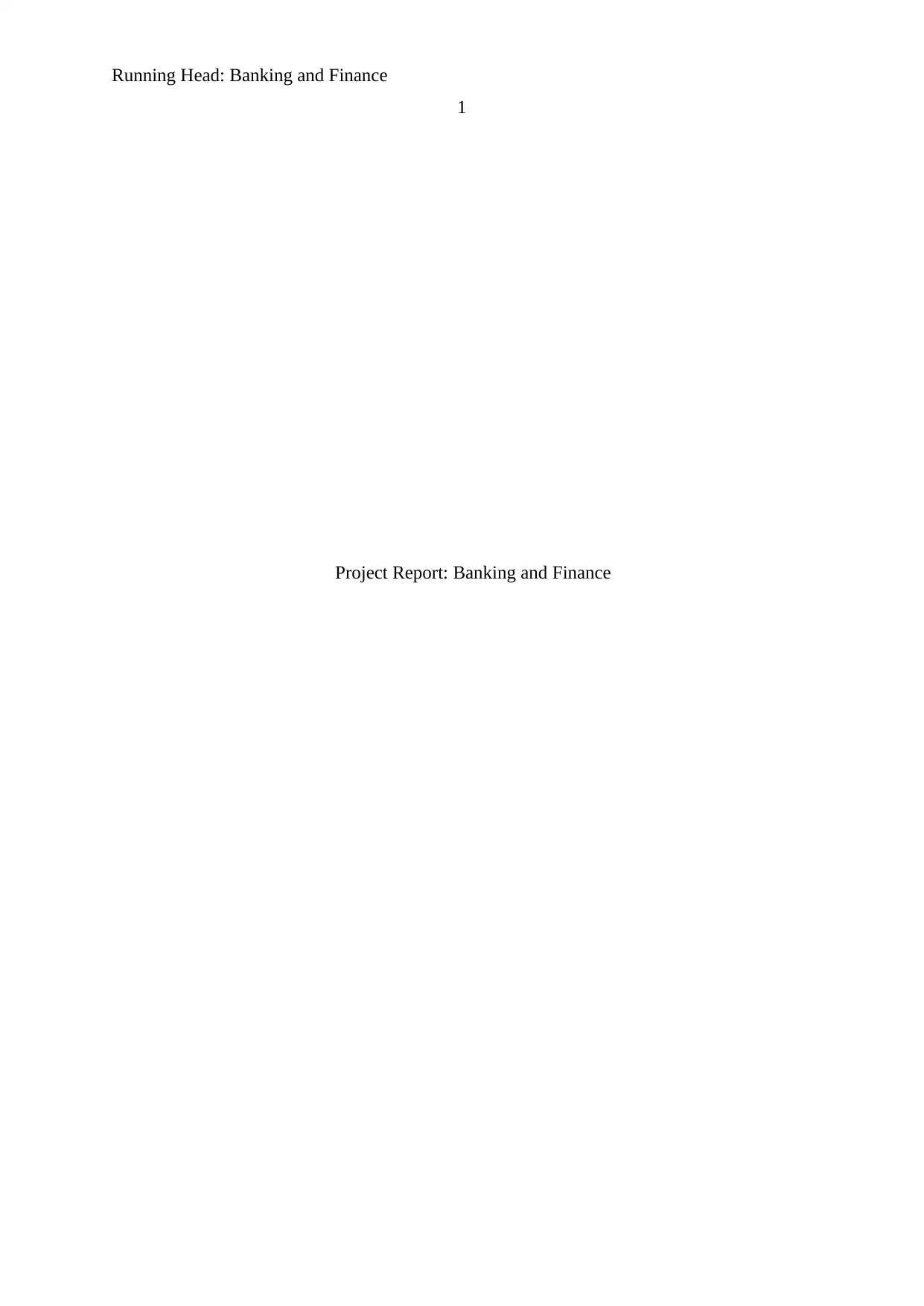
Running Head: Banking and Finance
1
Project Report: Banking and Finance
1
Project Report: Banking and Finance
Paraphrase This Document
Need a fresh take? Get an instant paraphrase of this document with our AI Paraphraser
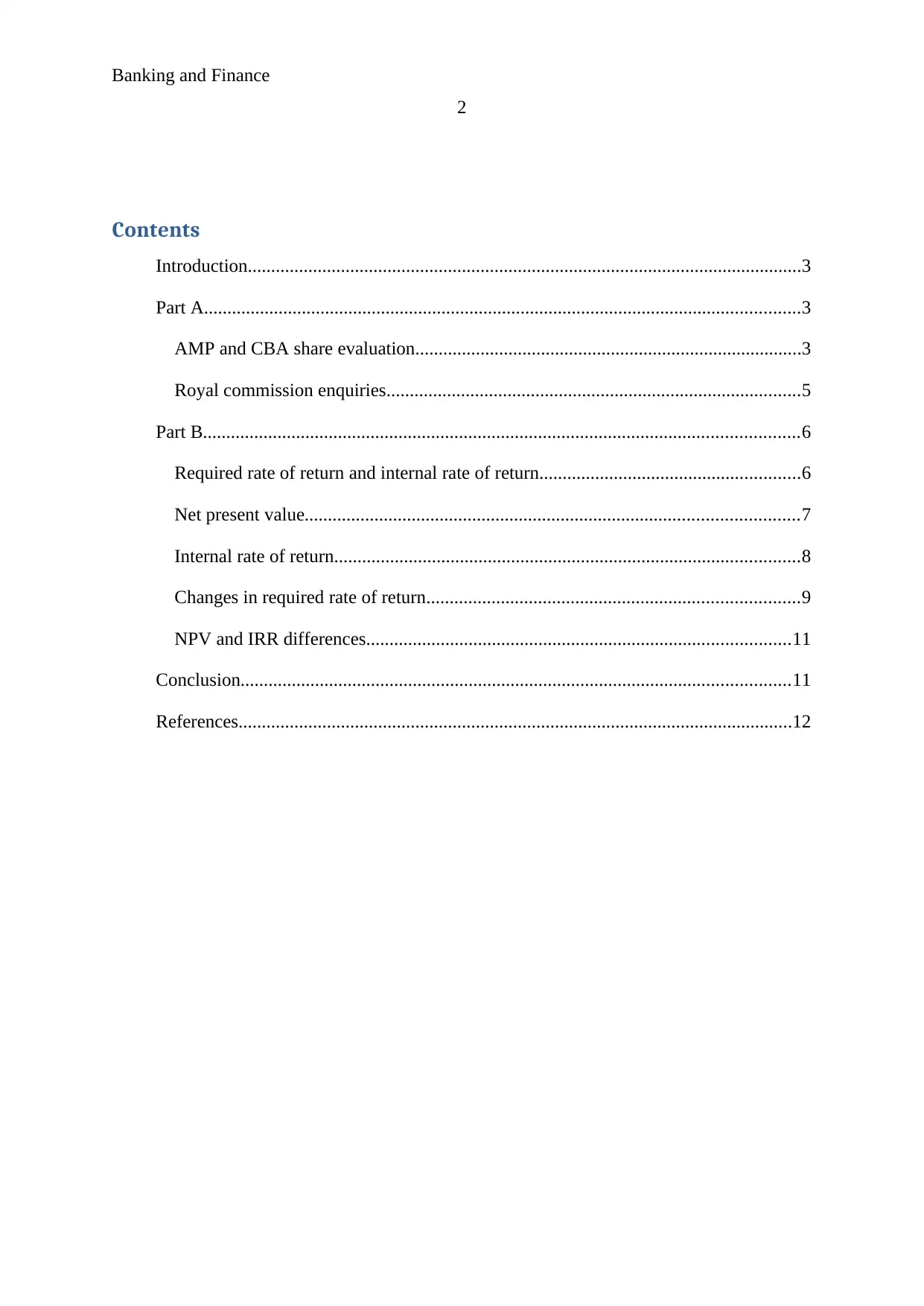
Banking and Finance
2
Contents
Introduction.......................................................................................................................3
Part A................................................................................................................................3
AMP and CBA share evaluation...................................................................................3
Royal commission enquiries.........................................................................................5
Part B................................................................................................................................6
Required rate of return and internal rate of return........................................................6
Net present value..........................................................................................................7
Internal rate of return....................................................................................................8
Changes in required rate of return................................................................................9
NPV and IRR differences...........................................................................................11
Conclusion......................................................................................................................11
References.......................................................................................................................12
2
Contents
Introduction.......................................................................................................................3
Part A................................................................................................................................3
AMP and CBA share evaluation...................................................................................3
Royal commission enquiries.........................................................................................5
Part B................................................................................................................................6
Required rate of return and internal rate of return........................................................6
Net present value..........................................................................................................7
Internal rate of return....................................................................................................8
Changes in required rate of return................................................................................9
NPV and IRR differences...........................................................................................11
Conclusion......................................................................................................................11
References.......................................................................................................................12
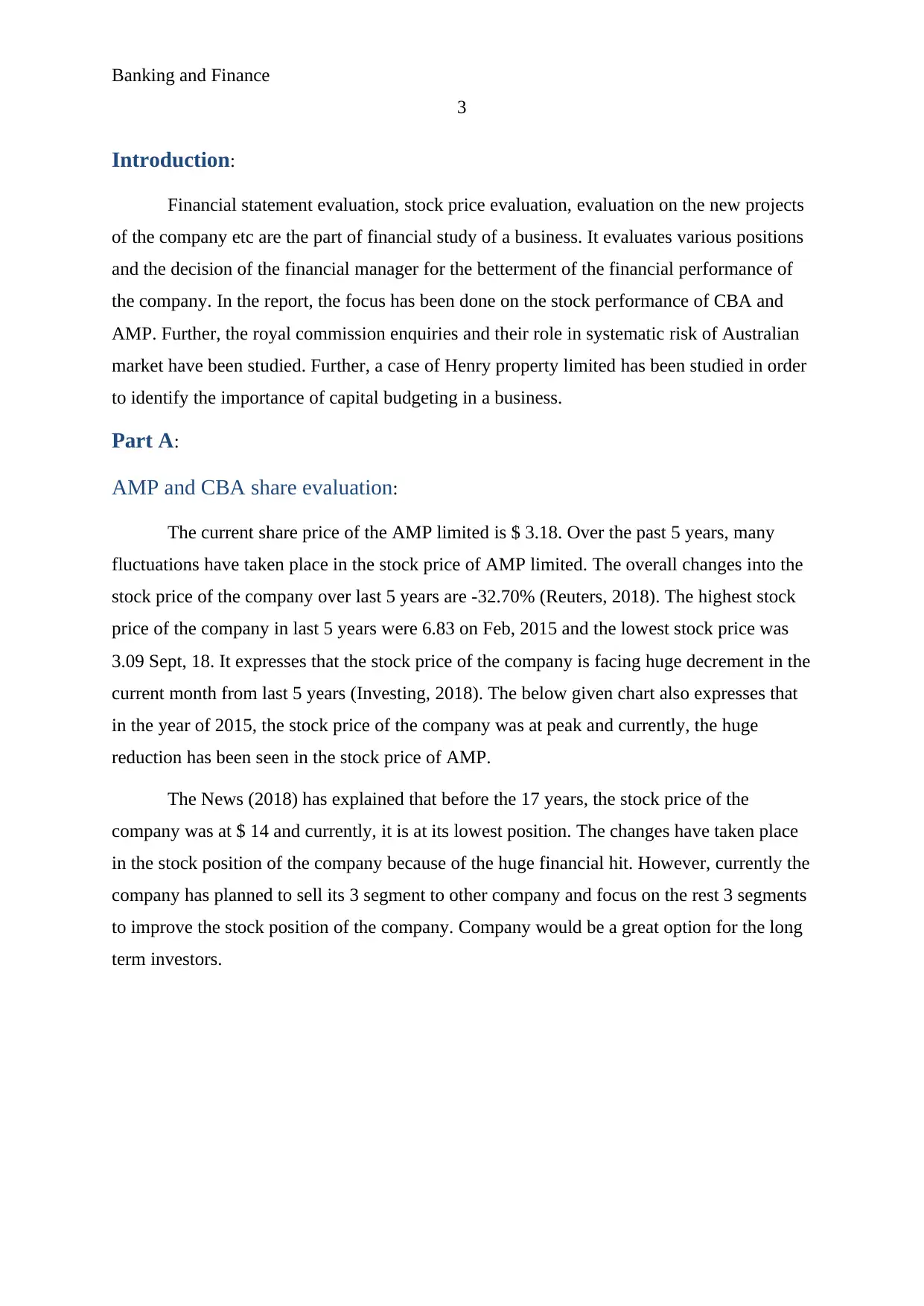
Banking and Finance
3
Introduction:
Financial statement evaluation, stock price evaluation, evaluation on the new projects
of the company etc are the part of financial study of a business. It evaluates various positions
and the decision of the financial manager for the betterment of the financial performance of
the company. In the report, the focus has been done on the stock performance of CBA and
AMP. Further, the royal commission enquiries and their role in systematic risk of Australian
market have been studied. Further, a case of Henry property limited has been studied in order
to identify the importance of capital budgeting in a business.
Part A:
AMP and CBA share evaluation:
The current share price of the AMP limited is $ 3.18. Over the past 5 years, many
fluctuations have taken place in the stock price of AMP limited. The overall changes into the
stock price of the company over last 5 years are -32.70% (Reuters, 2018). The highest stock
price of the company in last 5 years were 6.83 on Feb, 2015 and the lowest stock price was
3.09 Sept, 18. It expresses that the stock price of the company is facing huge decrement in the
current month from last 5 years (Investing, 2018). The below given chart also expresses that
in the year of 2015, the stock price of the company was at peak and currently, the huge
reduction has been seen in the stock price of AMP.
The News (2018) has explained that before the 17 years, the stock price of the
company was at $ 14 and currently, it is at its lowest position. The changes have taken place
in the stock position of the company because of the huge financial hit. However, currently the
company has planned to sell its 3 segment to other company and focus on the rest 3 segments
to improve the stock position of the company. Company would be a great option for the long
term investors.
3
Introduction:
Financial statement evaluation, stock price evaluation, evaluation on the new projects
of the company etc are the part of financial study of a business. It evaluates various positions
and the decision of the financial manager for the betterment of the financial performance of
the company. In the report, the focus has been done on the stock performance of CBA and
AMP. Further, the royal commission enquiries and their role in systematic risk of Australian
market have been studied. Further, a case of Henry property limited has been studied in order
to identify the importance of capital budgeting in a business.
Part A:
AMP and CBA share evaluation:
The current share price of the AMP limited is $ 3.18. Over the past 5 years, many
fluctuations have taken place in the stock price of AMP limited. The overall changes into the
stock price of the company over last 5 years are -32.70% (Reuters, 2018). The highest stock
price of the company in last 5 years were 6.83 on Feb, 2015 and the lowest stock price was
3.09 Sept, 18. It expresses that the stock price of the company is facing huge decrement in the
current month from last 5 years (Investing, 2018). The below given chart also expresses that
in the year of 2015, the stock price of the company was at peak and currently, the huge
reduction has been seen in the stock price of AMP.
The News (2018) has explained that before the 17 years, the stock price of the
company was at $ 14 and currently, it is at its lowest position. The changes have taken place
in the stock position of the company because of the huge financial hit. However, currently the
company has planned to sell its 3 segment to other company and focus on the rest 3 segments
to improve the stock position of the company. Company would be a great option for the long
term investors.
⊘ This is a preview!⊘
Do you want full access?
Subscribe today to unlock all pages.

Trusted by 1+ million students worldwide

Banking and Finance
4
Figure 1: AMP share price
(ASX, 2018)
The current share price of the CBA limited is $ 70.18. Over the past 5 years, many
fluctuations have taken place in the stock price of CBA limited. The overall changes into the
stock price of the company over last 5 years are -3.129%. The highest stock price of the
company in last 5 years was 96.168 on March, 2015 and the lowest stock price was 67.22
June, 18. It expresses that the stock price of the company has been changed in a great interval
(Investing, 2018). The below given chart also expresses that in the year of 2015, the stock
price of the company was at peak and currently, the reduction has been seen in the stock price
of the company.
The Reuters (2018) has explained that the changes in the company are not that much
huge. The changes have occurred into the stock price because of the some internal and
external changes in the business, such as in the year of 2015, the economical position of the
country was at its best which has helped the stock price of CBA to be improved as well.
4
Figure 1: AMP share price
(ASX, 2018)
The current share price of the CBA limited is $ 70.18. Over the past 5 years, many
fluctuations have taken place in the stock price of CBA limited. The overall changes into the
stock price of the company over last 5 years are -3.129%. The highest stock price of the
company in last 5 years was 96.168 on March, 2015 and the lowest stock price was 67.22
June, 18. It expresses that the stock price of the company has been changed in a great interval
(Investing, 2018). The below given chart also expresses that in the year of 2015, the stock
price of the company was at peak and currently, the reduction has been seen in the stock price
of the company.
The Reuters (2018) has explained that the changes in the company are not that much
huge. The changes have occurred into the stock price because of the some internal and
external changes in the business, such as in the year of 2015, the economical position of the
country was at its best which has helped the stock price of CBA to be improved as well.
Paraphrase This Document
Need a fresh take? Get an instant paraphrase of this document with our AI Paraphraser
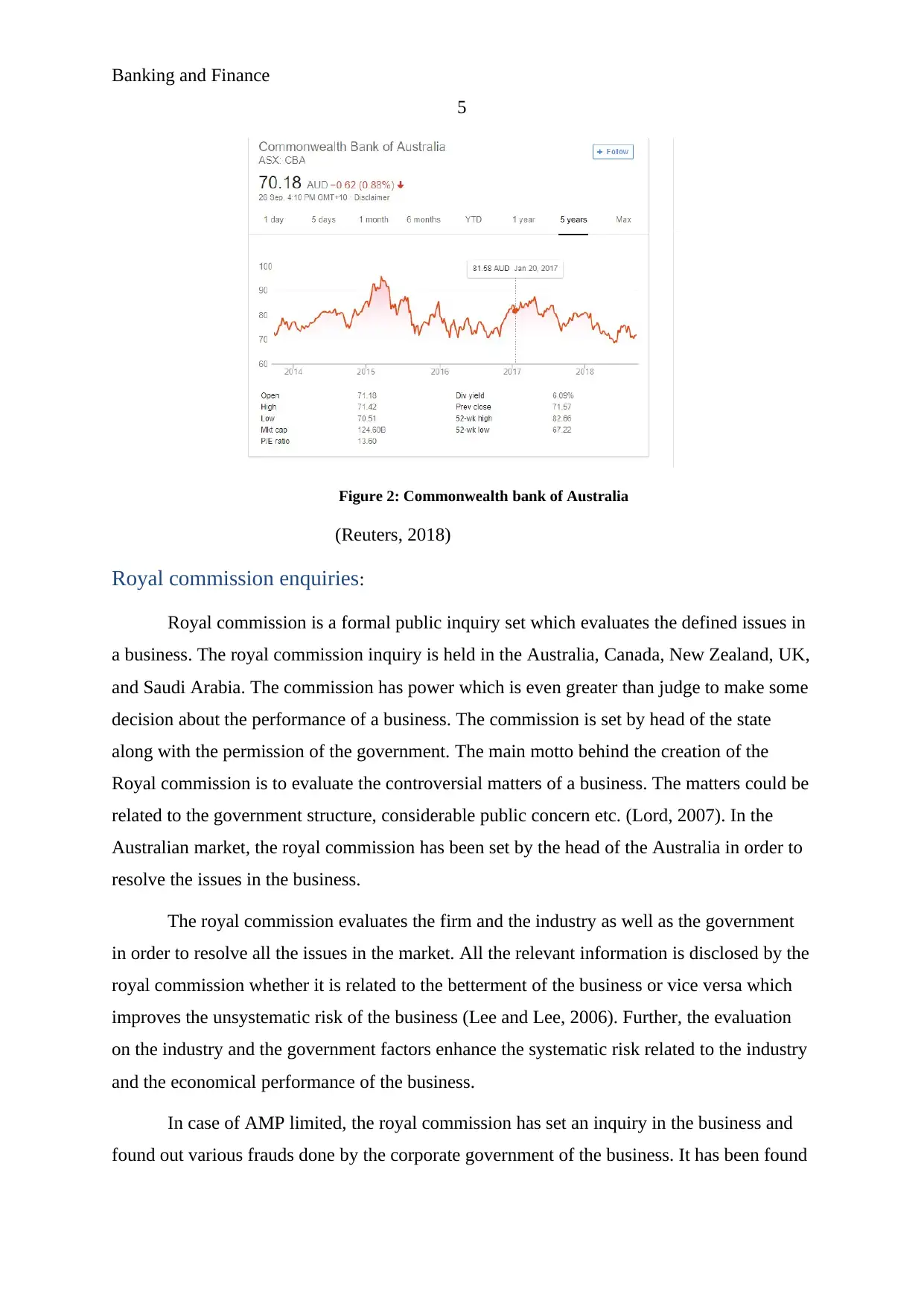
Banking and Finance
5
Figure 2: Commonwealth bank of Australia
(Reuters, 2018)
Royal commission enquiries:
Royal commission is a formal public inquiry set which evaluates the defined issues in
a business. The royal commission inquiry is held in the Australia, Canada, New Zealand, UK,
and Saudi Arabia. The commission has power which is even greater than judge to make some
decision about the performance of a business. The commission is set by head of the state
along with the permission of the government. The main motto behind the creation of the
Royal commission is to evaluate the controversial matters of a business. The matters could be
related to the government structure, considerable public concern etc. (Lord, 2007). In the
Australian market, the royal commission has been set by the head of the Australia in order to
resolve the issues in the business.
The royal commission evaluates the firm and the industry as well as the government
in order to resolve all the issues in the market. All the relevant information is disclosed by the
royal commission whether it is related to the betterment of the business or vice versa which
improves the unsystematic risk of the business (Lee and Lee, 2006). Further, the evaluation
on the industry and the government factors enhance the systematic risk related to the industry
and the economical performance of the business.
In case of AMP limited, the royal commission has set an inquiry in the business and
found out various frauds done by the corporate government of the business. It has been found
5
Figure 2: Commonwealth bank of Australia
(Reuters, 2018)
Royal commission enquiries:
Royal commission is a formal public inquiry set which evaluates the defined issues in
a business. The royal commission inquiry is held in the Australia, Canada, New Zealand, UK,
and Saudi Arabia. The commission has power which is even greater than judge to make some
decision about the performance of a business. The commission is set by head of the state
along with the permission of the government. The main motto behind the creation of the
Royal commission is to evaluate the controversial matters of a business. The matters could be
related to the government structure, considerable public concern etc. (Lord, 2007). In the
Australian market, the royal commission has been set by the head of the Australia in order to
resolve the issues in the business.
The royal commission evaluates the firm and the industry as well as the government
in order to resolve all the issues in the market. All the relevant information is disclosed by the
royal commission whether it is related to the betterment of the business or vice versa which
improves the unsystematic risk of the business (Lee and Lee, 2006). Further, the evaluation
on the industry and the government factors enhance the systematic risk related to the industry
and the economical performance of the business.
In case of AMP limited, the royal commission has set an inquiry in the business and
found out various frauds done by the corporate government of the business. It has been found
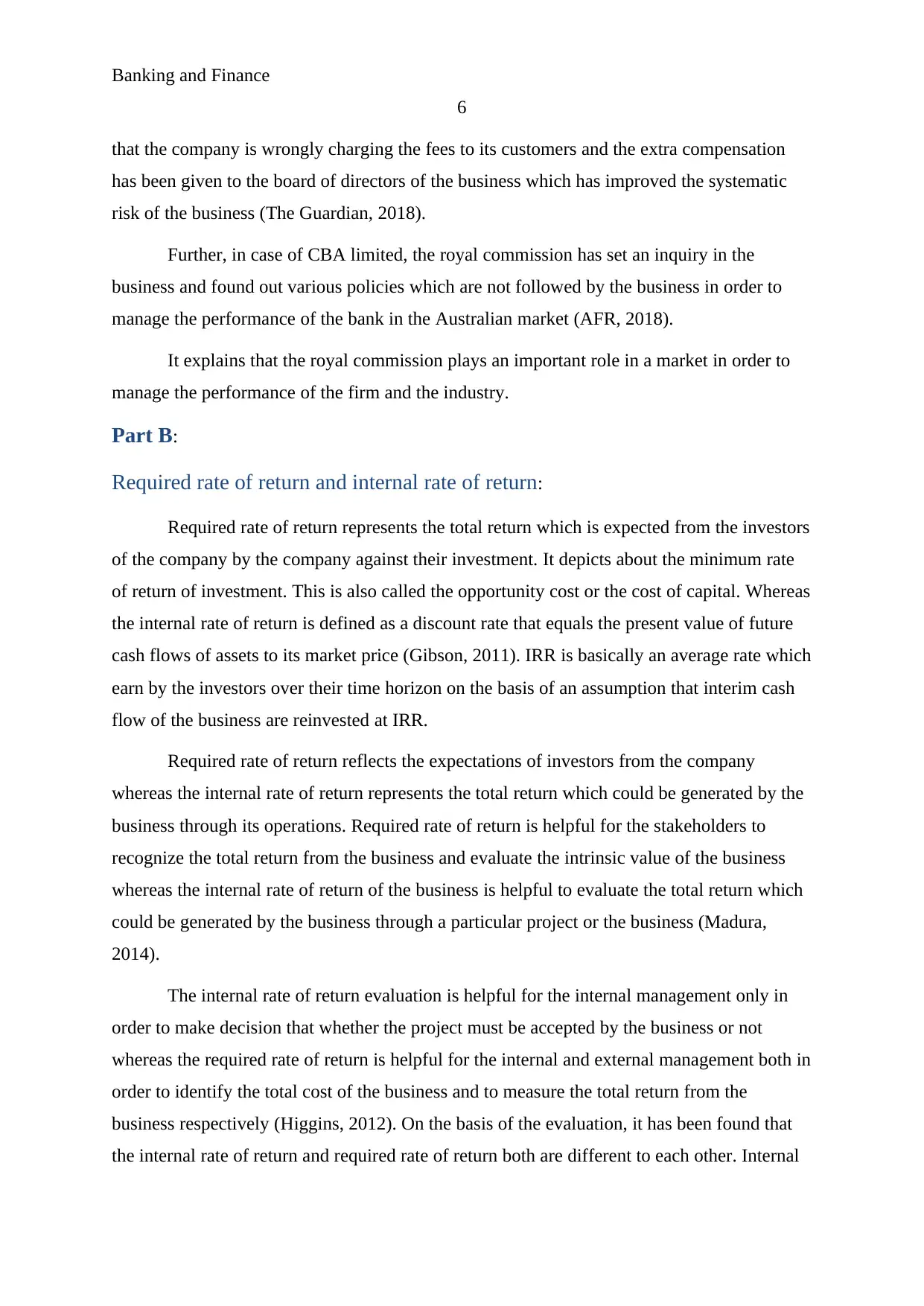
Banking and Finance
6
that the company is wrongly charging the fees to its customers and the extra compensation
has been given to the board of directors of the business which has improved the systematic
risk of the business (The Guardian, 2018).
Further, in case of CBA limited, the royal commission has set an inquiry in the
business and found out various policies which are not followed by the business in order to
manage the performance of the bank in the Australian market (AFR, 2018).
It explains that the royal commission plays an important role in a market in order to
manage the performance of the firm and the industry.
Part B:
Required rate of return and internal rate of return:
Required rate of return represents the total return which is expected from the investors
of the company by the company against their investment. It depicts about the minimum rate
of return of investment. This is also called the opportunity cost or the cost of capital. Whereas
the internal rate of return is defined as a discount rate that equals the present value of future
cash flows of assets to its market price (Gibson, 2011). IRR is basically an average rate which
earn by the investors over their time horizon on the basis of an assumption that interim cash
flow of the business are reinvested at IRR.
Required rate of return reflects the expectations of investors from the company
whereas the internal rate of return represents the total return which could be generated by the
business through its operations. Required rate of return is helpful for the stakeholders to
recognize the total return from the business and evaluate the intrinsic value of the business
whereas the internal rate of return of the business is helpful to evaluate the total return which
could be generated by the business through a particular project or the business (Madura,
2014).
The internal rate of return evaluation is helpful for the internal management only in
order to make decision that whether the project must be accepted by the business or not
whereas the required rate of return is helpful for the internal and external management both in
order to identify the total cost of the business and to measure the total return from the
business respectively (Higgins, 2012). On the basis of the evaluation, it has been found that
the internal rate of return and required rate of return both are different to each other. Internal
6
that the company is wrongly charging the fees to its customers and the extra compensation
has been given to the board of directors of the business which has improved the systematic
risk of the business (The Guardian, 2018).
Further, in case of CBA limited, the royal commission has set an inquiry in the
business and found out various policies which are not followed by the business in order to
manage the performance of the bank in the Australian market (AFR, 2018).
It explains that the royal commission plays an important role in a market in order to
manage the performance of the firm and the industry.
Part B:
Required rate of return and internal rate of return:
Required rate of return represents the total return which is expected from the investors
of the company by the company against their investment. It depicts about the minimum rate
of return of investment. This is also called the opportunity cost or the cost of capital. Whereas
the internal rate of return is defined as a discount rate that equals the present value of future
cash flows of assets to its market price (Gibson, 2011). IRR is basically an average rate which
earn by the investors over their time horizon on the basis of an assumption that interim cash
flow of the business are reinvested at IRR.
Required rate of return reflects the expectations of investors from the company
whereas the internal rate of return represents the total return which could be generated by the
business through its operations. Required rate of return is helpful for the stakeholders to
recognize the total return from the business and evaluate the intrinsic value of the business
whereas the internal rate of return of the business is helpful to evaluate the total return which
could be generated by the business through a particular project or the business (Madura,
2014).
The internal rate of return evaluation is helpful for the internal management only in
order to make decision that whether the project must be accepted by the business or not
whereas the required rate of return is helpful for the internal and external management both in
order to identify the total cost of the business and to measure the total return from the
business respectively (Higgins, 2012). On the basis of the evaluation, it has been found that
the internal rate of return and required rate of return both are different to each other. Internal
⊘ This is a preview!⊘
Do you want full access?
Subscribe today to unlock all pages.

Trusted by 1+ million students worldwide
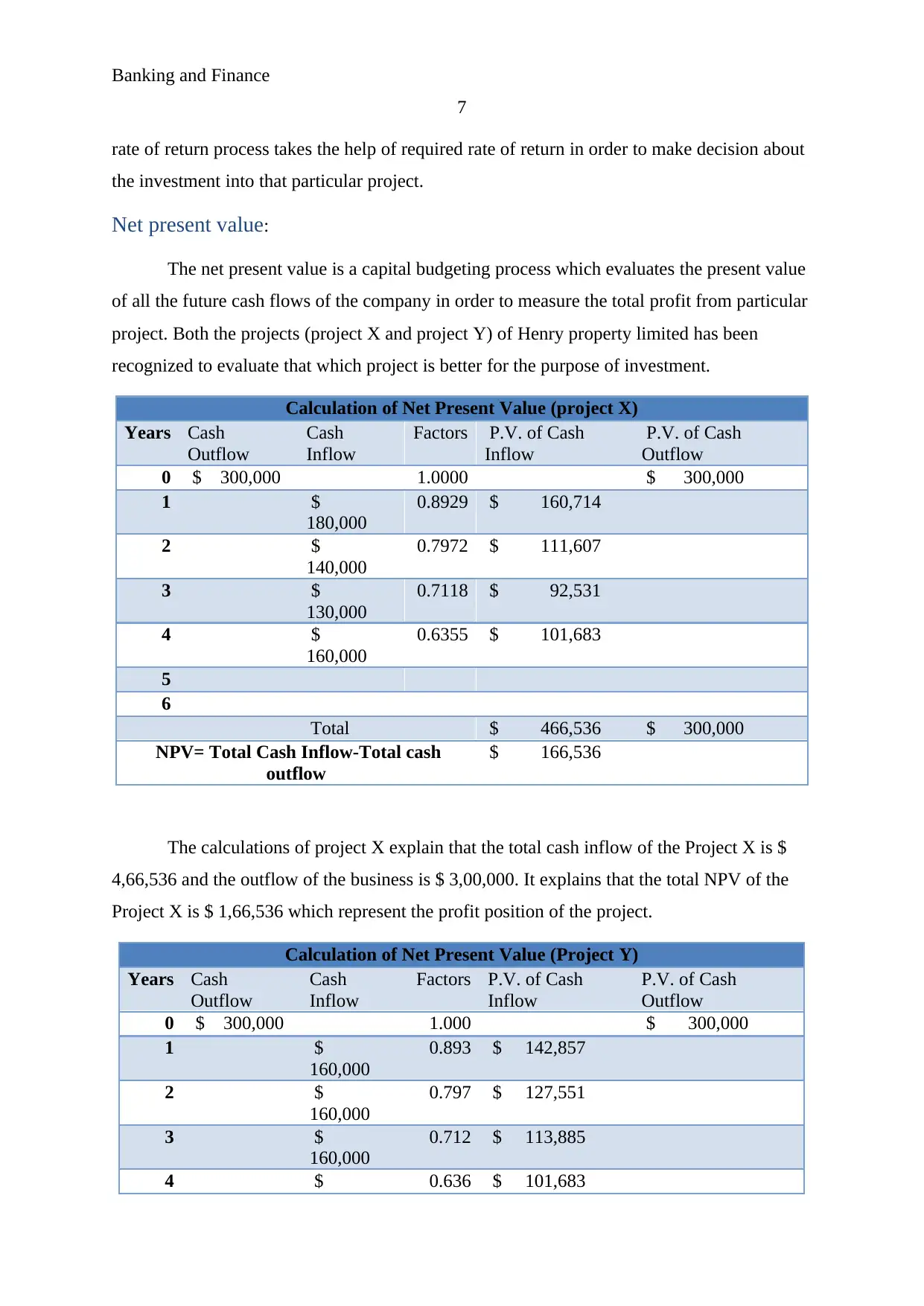
Banking and Finance
7
rate of return process takes the help of required rate of return in order to make decision about
the investment into that particular project.
Net present value:
The net present value is a capital budgeting process which evaluates the present value
of all the future cash flows of the company in order to measure the total profit from particular
project. Both the projects (project X and project Y) of Henry property limited has been
recognized to evaluate that which project is better for the purpose of investment.
Calculation of Net Present Value (project X)
Years Cash
Outflow
Cash
Inflow
Factors P.V. of Cash
Inflow
P.V. of Cash
Outflow
0 $ 300,000 1.0000 $ 300,000
1 $
180,000
0.8929 $ 160,714
2 $
140,000
0.7972 $ 111,607
3 $
130,000
0.7118 $ 92,531
4 $
160,000
0.6355 $ 101,683
5
6
Total $ 466,536 $ 300,000
NPV= Total Cash Inflow-Total cash
outflow
$ 166,536
The calculations of project X explain that the total cash inflow of the Project X is $
4,66,536 and the outflow of the business is $ 3,00,000. It explains that the total NPV of the
Project X is $ 1,66,536 which represent the profit position of the project.
Calculation of Net Present Value (Project Y)
Years Cash
Outflow
Cash
Inflow
Factors P.V. of Cash
Inflow
P.V. of Cash
Outflow
0 $ 300,000 1.000 $ 300,000
1 $
160,000
0.893 $ 142,857
2 $
160,000
0.797 $ 127,551
3 $
160,000
0.712 $ 113,885
4 $ 0.636 $ 101,683
7
rate of return process takes the help of required rate of return in order to make decision about
the investment into that particular project.
Net present value:
The net present value is a capital budgeting process which evaluates the present value
of all the future cash flows of the company in order to measure the total profit from particular
project. Both the projects (project X and project Y) of Henry property limited has been
recognized to evaluate that which project is better for the purpose of investment.
Calculation of Net Present Value (project X)
Years Cash
Outflow
Cash
Inflow
Factors P.V. of Cash
Inflow
P.V. of Cash
Outflow
0 $ 300,000 1.0000 $ 300,000
1 $
180,000
0.8929 $ 160,714
2 $
140,000
0.7972 $ 111,607
3 $
130,000
0.7118 $ 92,531
4 $
160,000
0.6355 $ 101,683
5
6
Total $ 466,536 $ 300,000
NPV= Total Cash Inflow-Total cash
outflow
$ 166,536
The calculations of project X explain that the total cash inflow of the Project X is $
4,66,536 and the outflow of the business is $ 3,00,000. It explains that the total NPV of the
Project X is $ 1,66,536 which represent the profit position of the project.
Calculation of Net Present Value (Project Y)
Years Cash
Outflow
Cash
Inflow
Factors P.V. of Cash
Inflow
P.V. of Cash
Outflow
0 $ 300,000 1.000 $ 300,000
1 $
160,000
0.893 $ 142,857
2 $
160,000
0.797 $ 127,551
3 $
160,000
0.712 $ 113,885
4 $ 0.636 $ 101,683
Paraphrase This Document
Need a fresh take? Get an instant paraphrase of this document with our AI Paraphraser
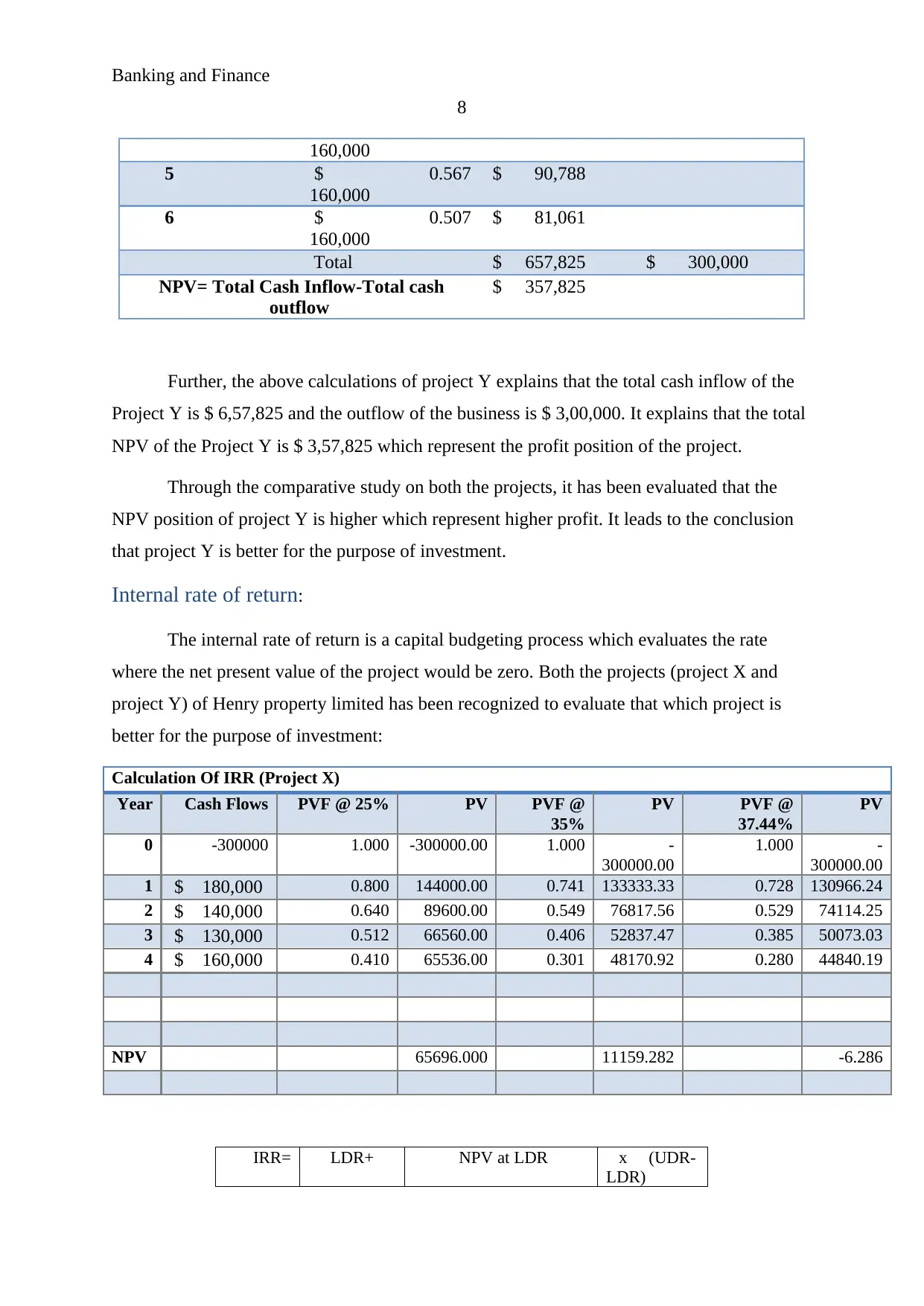
Banking and Finance
8
160,000
5 $
160,000
0.567 $ 90,788
6 $
160,000
0.507 $ 81,061
Total $ 657,825 $ 300,000
NPV= Total Cash Inflow-Total cash
outflow
$ 357,825
Further, the above calculations of project Y explains that the total cash inflow of the
Project Y is $ 6,57,825 and the outflow of the business is $ 3,00,000. It explains that the total
NPV of the Project Y is $ 3,57,825 which represent the profit position of the project.
Through the comparative study on both the projects, it has been evaluated that the
NPV position of project Y is higher which represent higher profit. It leads to the conclusion
that project Y is better for the purpose of investment.
Internal rate of return:
The internal rate of return is a capital budgeting process which evaluates the rate
where the net present value of the project would be zero. Both the projects (project X and
project Y) of Henry property limited has been recognized to evaluate that which project is
better for the purpose of investment:
Calculation Of IRR (Project X)
Year Cash Flows PVF @ 25% PV PVF @
35%
PV PVF @
37.44%
PV
0 -300000 1.000 -300000.00 1.000 -
300000.00
1.000 -
300000.00
1 $ 180,000 0.800 144000.00 0.741 133333.33 0.728 130966.24
2 $ 140,000 0.640 89600.00 0.549 76817.56 0.529 74114.25
3 $ 130,000 0.512 66560.00 0.406 52837.47 0.385 50073.03
4 $ 160,000 0.410 65536.00 0.301 48170.92 0.280 44840.19
NPV 65696.000 11159.282 -6.286
IRR= LDR+ NPV at LDR x (UDR-
LDR)
8
160,000
5 $
160,000
0.567 $ 90,788
6 $
160,000
0.507 $ 81,061
Total $ 657,825 $ 300,000
NPV= Total Cash Inflow-Total cash
outflow
$ 357,825
Further, the above calculations of project Y explains that the total cash inflow of the
Project Y is $ 6,57,825 and the outflow of the business is $ 3,00,000. It explains that the total
NPV of the Project Y is $ 3,57,825 which represent the profit position of the project.
Through the comparative study on both the projects, it has been evaluated that the
NPV position of project Y is higher which represent higher profit. It leads to the conclusion
that project Y is better for the purpose of investment.
Internal rate of return:
The internal rate of return is a capital budgeting process which evaluates the rate
where the net present value of the project would be zero. Both the projects (project X and
project Y) of Henry property limited has been recognized to evaluate that which project is
better for the purpose of investment:
Calculation Of IRR (Project X)
Year Cash Flows PVF @ 25% PV PVF @
35%
PV PVF @
37.44%
PV
0 -300000 1.000 -300000.00 1.000 -
300000.00
1.000 -
300000.00
1 $ 180,000 0.800 144000.00 0.741 133333.33 0.728 130966.24
2 $ 140,000 0.640 89600.00 0.549 76817.56 0.529 74114.25
3 $ 130,000 0.512 66560.00 0.406 52837.47 0.385 50073.03
4 $ 160,000 0.410 65536.00 0.301 48170.92 0.280 44840.19
NPV 65696.000 11159.282 -6.286
IRR= LDR+ NPV at LDR x (UDR-
LDR)
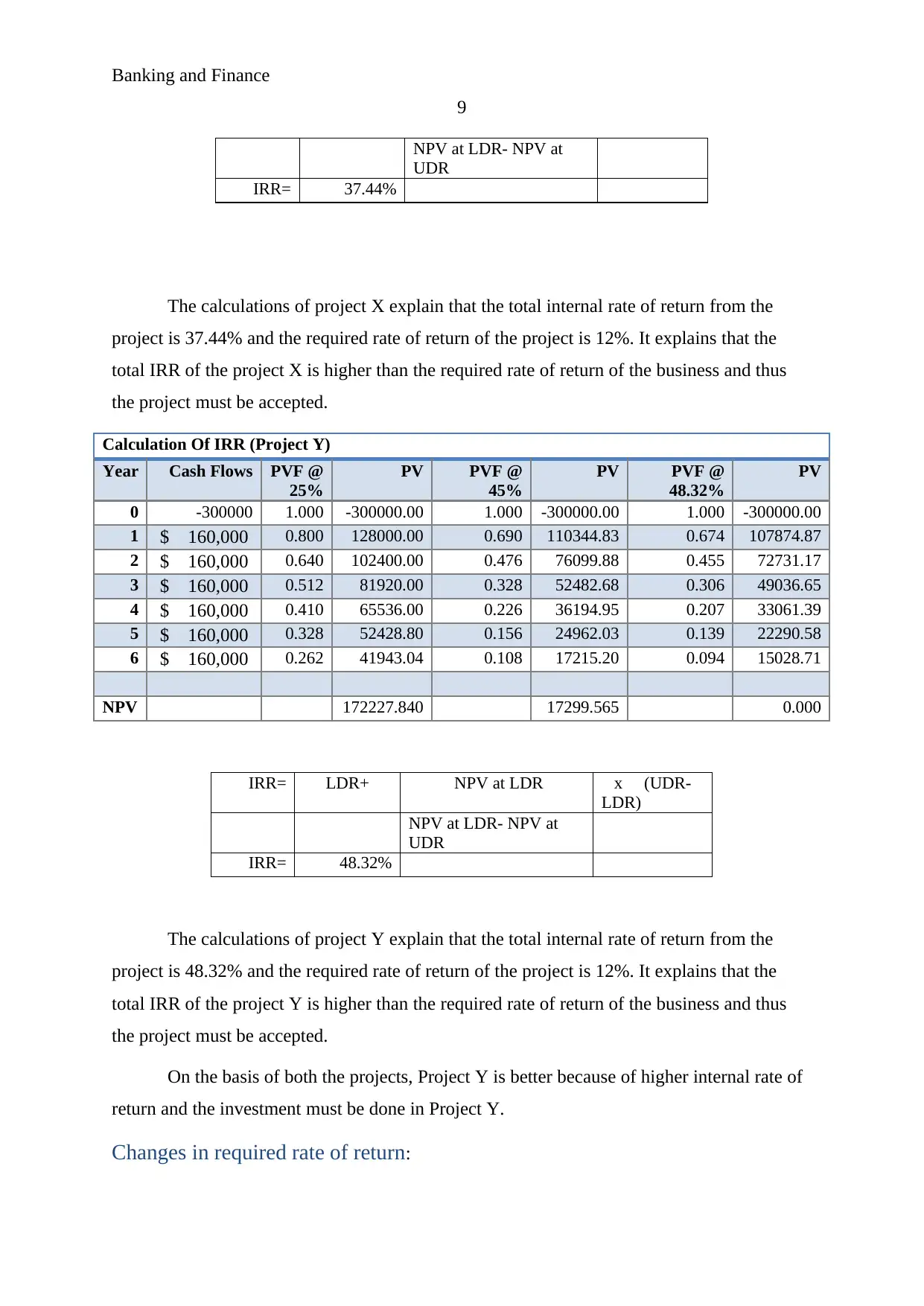
Banking and Finance
9
NPV at LDR- NPV at
UDR
IRR= 37.44%
The calculations of project X explain that the total internal rate of return from the
project is 37.44% and the required rate of return of the project is 12%. It explains that the
total IRR of the project X is higher than the required rate of return of the business and thus
the project must be accepted.
Calculation Of IRR (Project Y)
Year Cash Flows PVF @
25%
PV PVF @
45%
PV PVF @
48.32%
PV
0 -300000 1.000 -300000.00 1.000 -300000.00 1.000 -300000.00
1 $ 160,000 0.800 128000.00 0.690 110344.83 0.674 107874.87
2 $ 160,000 0.640 102400.00 0.476 76099.88 0.455 72731.17
3 $ 160,000 0.512 81920.00 0.328 52482.68 0.306 49036.65
4 $ 160,000 0.410 65536.00 0.226 36194.95 0.207 33061.39
5 $ 160,000 0.328 52428.80 0.156 24962.03 0.139 22290.58
6 $ 160,000 0.262 41943.04 0.108 17215.20 0.094 15028.71
NPV 172227.840 17299.565 0.000
IRR= LDR+ NPV at LDR x (UDR-
LDR)
NPV at LDR- NPV at
UDR
IRR= 48.32%
The calculations of project Y explain that the total internal rate of return from the
project is 48.32% and the required rate of return of the project is 12%. It explains that the
total IRR of the project Y is higher than the required rate of return of the business and thus
the project must be accepted.
On the basis of both the projects, Project Y is better because of higher internal rate of
return and the investment must be done in Project Y.
Changes in required rate of return:
9
NPV at LDR- NPV at
UDR
IRR= 37.44%
The calculations of project X explain that the total internal rate of return from the
project is 37.44% and the required rate of return of the project is 12%. It explains that the
total IRR of the project X is higher than the required rate of return of the business and thus
the project must be accepted.
Calculation Of IRR (Project Y)
Year Cash Flows PVF @
25%
PV PVF @
45%
PV PVF @
48.32%
PV
0 -300000 1.000 -300000.00 1.000 -300000.00 1.000 -300000.00
1 $ 160,000 0.800 128000.00 0.690 110344.83 0.674 107874.87
2 $ 160,000 0.640 102400.00 0.476 76099.88 0.455 72731.17
3 $ 160,000 0.512 81920.00 0.328 52482.68 0.306 49036.65
4 $ 160,000 0.410 65536.00 0.226 36194.95 0.207 33061.39
5 $ 160,000 0.328 52428.80 0.156 24962.03 0.139 22290.58
6 $ 160,000 0.262 41943.04 0.108 17215.20 0.094 15028.71
NPV 172227.840 17299.565 0.000
IRR= LDR+ NPV at LDR x (UDR-
LDR)
NPV at LDR- NPV at
UDR
IRR= 48.32%
The calculations of project Y explain that the total internal rate of return from the
project is 48.32% and the required rate of return of the project is 12%. It explains that the
total IRR of the project Y is higher than the required rate of return of the business and thus
the project must be accepted.
On the basis of both the projects, Project Y is better because of higher internal rate of
return and the investment must be done in Project Y.
Changes in required rate of return:
⊘ This is a preview!⊘
Do you want full access?
Subscribe today to unlock all pages.

Trusted by 1+ million students worldwide
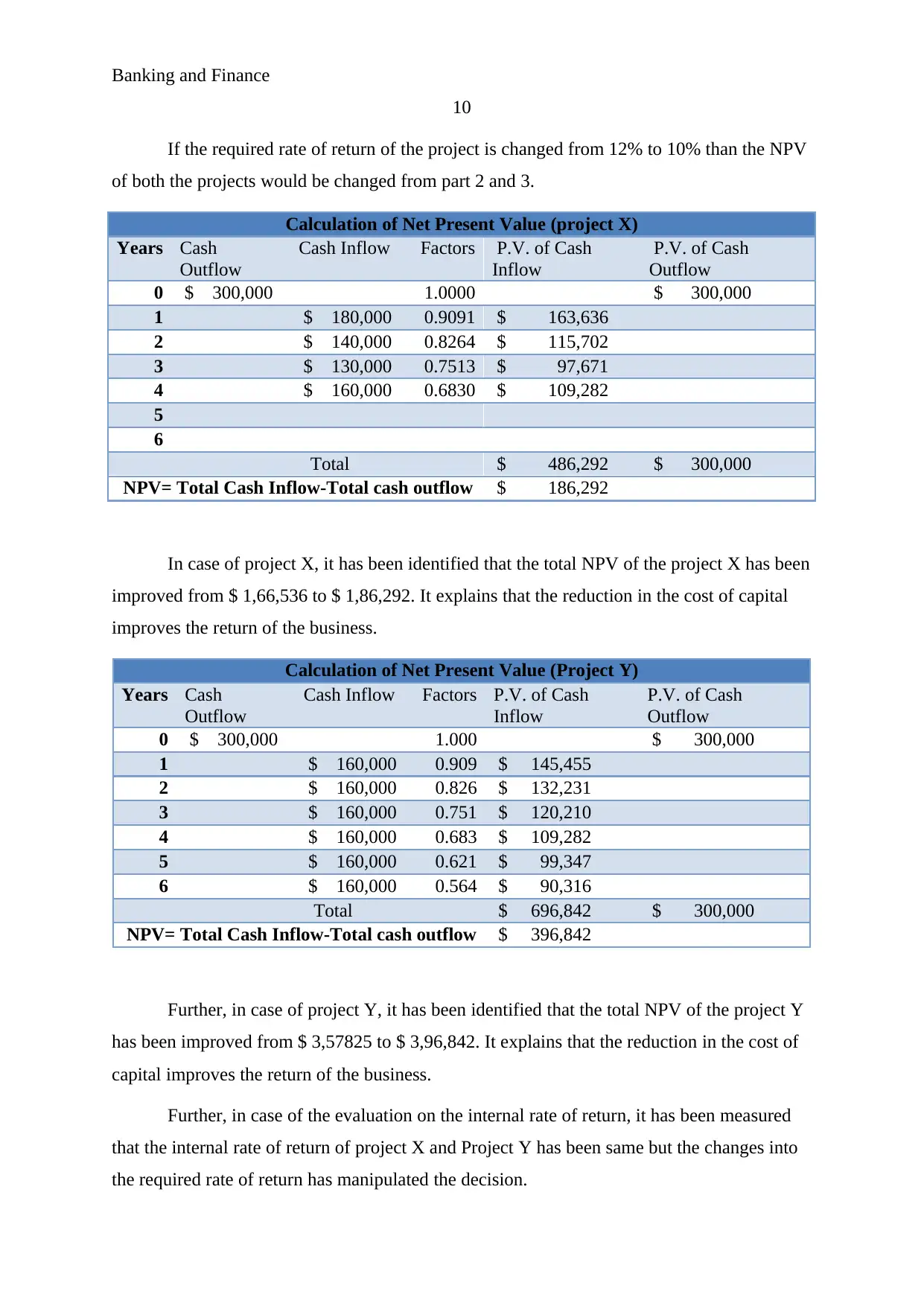
Banking and Finance
10
If the required rate of return of the project is changed from 12% to 10% than the NPV
of both the projects would be changed from part 2 and 3.
Calculation of Net Present Value (project X)
Years Cash
Outflow
Cash Inflow Factors P.V. of Cash
Inflow
P.V. of Cash
Outflow
0 $ 300,000 1.0000 $ 300,000
1 $ 180,000 0.9091 $ 163,636
2 $ 140,000 0.8264 $ 115,702
3 $ 130,000 0.7513 $ 97,671
4 $ 160,000 0.6830 $ 109,282
5
6
Total $ 486,292 $ 300,000
NPV= Total Cash Inflow-Total cash outflow $ 186,292
In case of project X, it has been identified that the total NPV of the project X has been
improved from $ 1,66,536 to $ 1,86,292. It explains that the reduction in the cost of capital
improves the return of the business.
Calculation of Net Present Value (Project Y)
Years Cash
Outflow
Cash Inflow Factors P.V. of Cash
Inflow
P.V. of Cash
Outflow
0 $ 300,000 1.000 $ 300,000
1 $ 160,000 0.909 $ 145,455
2 $ 160,000 0.826 $ 132,231
3 $ 160,000 0.751 $ 120,210
4 $ 160,000 0.683 $ 109,282
5 $ 160,000 0.621 $ 99,347
6 $ 160,000 0.564 $ 90,316
Total $ 696,842 $ 300,000
NPV= Total Cash Inflow-Total cash outflow $ 396,842
Further, in case of project Y, it has been identified that the total NPV of the project Y
has been improved from $ 3,57825 to $ 3,96,842. It explains that the reduction in the cost of
capital improves the return of the business.
Further, in case of the evaluation on the internal rate of return, it has been measured
that the internal rate of return of project X and Project Y has been same but the changes into
the required rate of return has manipulated the decision.
10
If the required rate of return of the project is changed from 12% to 10% than the NPV
of both the projects would be changed from part 2 and 3.
Calculation of Net Present Value (project X)
Years Cash
Outflow
Cash Inflow Factors P.V. of Cash
Inflow
P.V. of Cash
Outflow
0 $ 300,000 1.0000 $ 300,000
1 $ 180,000 0.9091 $ 163,636
2 $ 140,000 0.8264 $ 115,702
3 $ 130,000 0.7513 $ 97,671
4 $ 160,000 0.6830 $ 109,282
5
6
Total $ 486,292 $ 300,000
NPV= Total Cash Inflow-Total cash outflow $ 186,292
In case of project X, it has been identified that the total NPV of the project X has been
improved from $ 1,66,536 to $ 1,86,292. It explains that the reduction in the cost of capital
improves the return of the business.
Calculation of Net Present Value (Project Y)
Years Cash
Outflow
Cash Inflow Factors P.V. of Cash
Inflow
P.V. of Cash
Outflow
0 $ 300,000 1.000 $ 300,000
1 $ 160,000 0.909 $ 145,455
2 $ 160,000 0.826 $ 132,231
3 $ 160,000 0.751 $ 120,210
4 $ 160,000 0.683 $ 109,282
5 $ 160,000 0.621 $ 99,347
6 $ 160,000 0.564 $ 90,316
Total $ 696,842 $ 300,000
NPV= Total Cash Inflow-Total cash outflow $ 396,842
Further, in case of project Y, it has been identified that the total NPV of the project Y
has been improved from $ 3,57825 to $ 3,96,842. It explains that the reduction in the cost of
capital improves the return of the business.
Further, in case of the evaluation on the internal rate of return, it has been measured
that the internal rate of return of project X and Project Y has been same but the changes into
the required rate of return has manipulated the decision.
Paraphrase This Document
Need a fresh take? Get an instant paraphrase of this document with our AI Paraphraser
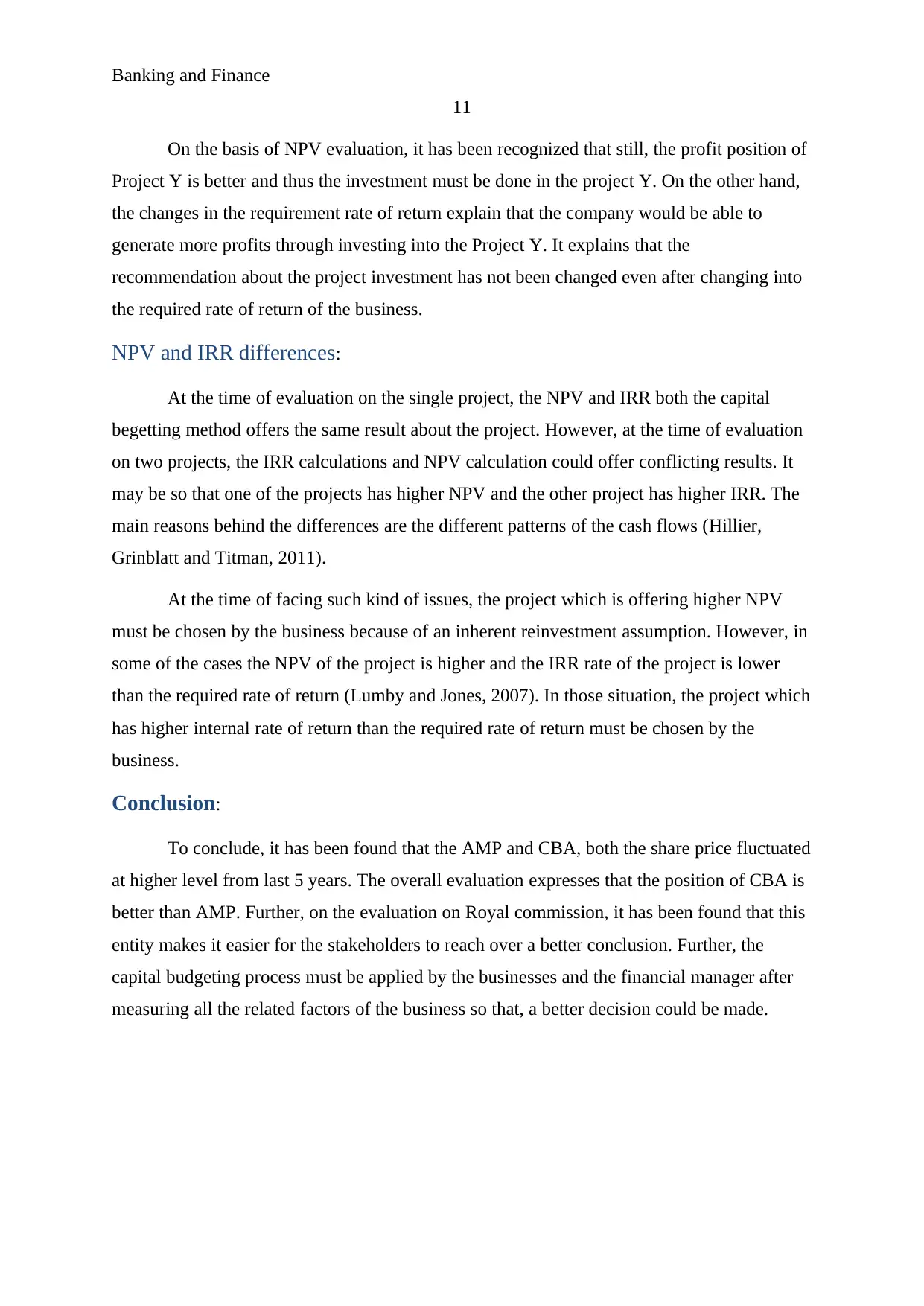
Banking and Finance
11
On the basis of NPV evaluation, it has been recognized that still, the profit position of
Project Y is better and thus the investment must be done in the project Y. On the other hand,
the changes in the requirement rate of return explain that the company would be able to
generate more profits through investing into the Project Y. It explains that the
recommendation about the project investment has not been changed even after changing into
the required rate of return of the business.
NPV and IRR differences:
At the time of evaluation on the single project, the NPV and IRR both the capital
begetting method offers the same result about the project. However, at the time of evaluation
on two projects, the IRR calculations and NPV calculation could offer conflicting results. It
may be so that one of the projects has higher NPV and the other project has higher IRR. The
main reasons behind the differences are the different patterns of the cash flows (Hillier,
Grinblatt and Titman, 2011).
At the time of facing such kind of issues, the project which is offering higher NPV
must be chosen by the business because of an inherent reinvestment assumption. However, in
some of the cases the NPV of the project is higher and the IRR rate of the project is lower
than the required rate of return (Lumby and Jones, 2007). In those situation, the project which
has higher internal rate of return than the required rate of return must be chosen by the
business.
Conclusion:
To conclude, it has been found that the AMP and CBA, both the share price fluctuated
at higher level from last 5 years. The overall evaluation expresses that the position of CBA is
better than AMP. Further, on the evaluation on Royal commission, it has been found that this
entity makes it easier for the stakeholders to reach over a better conclusion. Further, the
capital budgeting process must be applied by the businesses and the financial manager after
measuring all the related factors of the business so that, a better decision could be made.
11
On the basis of NPV evaluation, it has been recognized that still, the profit position of
Project Y is better and thus the investment must be done in the project Y. On the other hand,
the changes in the requirement rate of return explain that the company would be able to
generate more profits through investing into the Project Y. It explains that the
recommendation about the project investment has not been changed even after changing into
the required rate of return of the business.
NPV and IRR differences:
At the time of evaluation on the single project, the NPV and IRR both the capital
begetting method offers the same result about the project. However, at the time of evaluation
on two projects, the IRR calculations and NPV calculation could offer conflicting results. It
may be so that one of the projects has higher NPV and the other project has higher IRR. The
main reasons behind the differences are the different patterns of the cash flows (Hillier,
Grinblatt and Titman, 2011).
At the time of facing such kind of issues, the project which is offering higher NPV
must be chosen by the business because of an inherent reinvestment assumption. However, in
some of the cases the NPV of the project is higher and the IRR rate of the project is lower
than the required rate of return (Lumby and Jones, 2007). In those situation, the project which
has higher internal rate of return than the required rate of return must be chosen by the
business.
Conclusion:
To conclude, it has been found that the AMP and CBA, both the share price fluctuated
at higher level from last 5 years. The overall evaluation expresses that the position of CBA is
better than AMP. Further, on the evaluation on Royal commission, it has been found that this
entity makes it easier for the stakeholders to reach over a better conclusion. Further, the
capital budgeting process must be applied by the businesses and the financial manager after
measuring all the related factors of the business so that, a better decision could be made.

Banking and Finance
12
References:
AFR. 2018. Commonwealth bank of Australia. [online]. Available at:
https://www.afr.com/business/banking-and-finance/financial-services/banking-royal-
commission-nab-commonwealth-bank-deny-breaking-the-law-20180903-h14uv9 (accessed
26/9/18).
ASX. 2018. AMP limited. [online]. Available at: https://www.asx.com.au/asx/share-price-
research/company/AMP (accessed 26/9/18).
Gibson, C.H., 2011. Financial reporting and analysis. South-Western Cengage Learning.
Higgins, R.C., 2012. Analysis for financial management. McGraw-Hill/Irwin.
Hillier, D., Grinblatt, M. and Titman, S., 2011. Financial markets and corporate strategy.
McGraw Hill.
Investing. 2018. AMP limited. [online]. Available at: https://au.investing.com/equities/amp-
limited-historical-data (accessed 26/9/18).
Investing. 2018. Commonwealth bank of Australia. [online]. Available at:
https://au.investing.com/equities/commonwealth-bank-of-australia-historical-data (accessed
26/9/18).
Lee.C.F and Lee, A, C,.2006. Encyclopedia of finance, Springer science, new York.
Lord, B.R., 2007. Strategic management accounting. Issues in Management Accounting, 3.
Lumby,S and Jones,C,.2007. Corporate finance theory & practice, 7th edition, Thomson,
London.
Madura, J. 2014. Financial Markets and Institutions. Cengage Learning.
NEWS. 2018. AMP limited. [online]. Available at:
http://www.abc.net.au/news/2018-05-23/amp-in-crisis-can-it-survive/9788690 (accessed
26/9/18).
Reuters. 2018. AMP limited. [online]. Available at:
https://www.reuters.com/finance/stocks/AMP.AX/key-developments (accessed 26/9/18).
12
References:
AFR. 2018. Commonwealth bank of Australia. [online]. Available at:
https://www.afr.com/business/banking-and-finance/financial-services/banking-royal-
commission-nab-commonwealth-bank-deny-breaking-the-law-20180903-h14uv9 (accessed
26/9/18).
ASX. 2018. AMP limited. [online]. Available at: https://www.asx.com.au/asx/share-price-
research/company/AMP (accessed 26/9/18).
Gibson, C.H., 2011. Financial reporting and analysis. South-Western Cengage Learning.
Higgins, R.C., 2012. Analysis for financial management. McGraw-Hill/Irwin.
Hillier, D., Grinblatt, M. and Titman, S., 2011. Financial markets and corporate strategy.
McGraw Hill.
Investing. 2018. AMP limited. [online]. Available at: https://au.investing.com/equities/amp-
limited-historical-data (accessed 26/9/18).
Investing. 2018. Commonwealth bank of Australia. [online]. Available at:
https://au.investing.com/equities/commonwealth-bank-of-australia-historical-data (accessed
26/9/18).
Lee.C.F and Lee, A, C,.2006. Encyclopedia of finance, Springer science, new York.
Lord, B.R., 2007. Strategic management accounting. Issues in Management Accounting, 3.
Lumby,S and Jones,C,.2007. Corporate finance theory & practice, 7th edition, Thomson,
London.
Madura, J. 2014. Financial Markets and Institutions. Cengage Learning.
NEWS. 2018. AMP limited. [online]. Available at:
http://www.abc.net.au/news/2018-05-23/amp-in-crisis-can-it-survive/9788690 (accessed
26/9/18).
Reuters. 2018. AMP limited. [online]. Available at:
https://www.reuters.com/finance/stocks/AMP.AX/key-developments (accessed 26/9/18).
⊘ This is a preview!⊘
Do you want full access?
Subscribe today to unlock all pages.

Trusted by 1+ million students worldwide
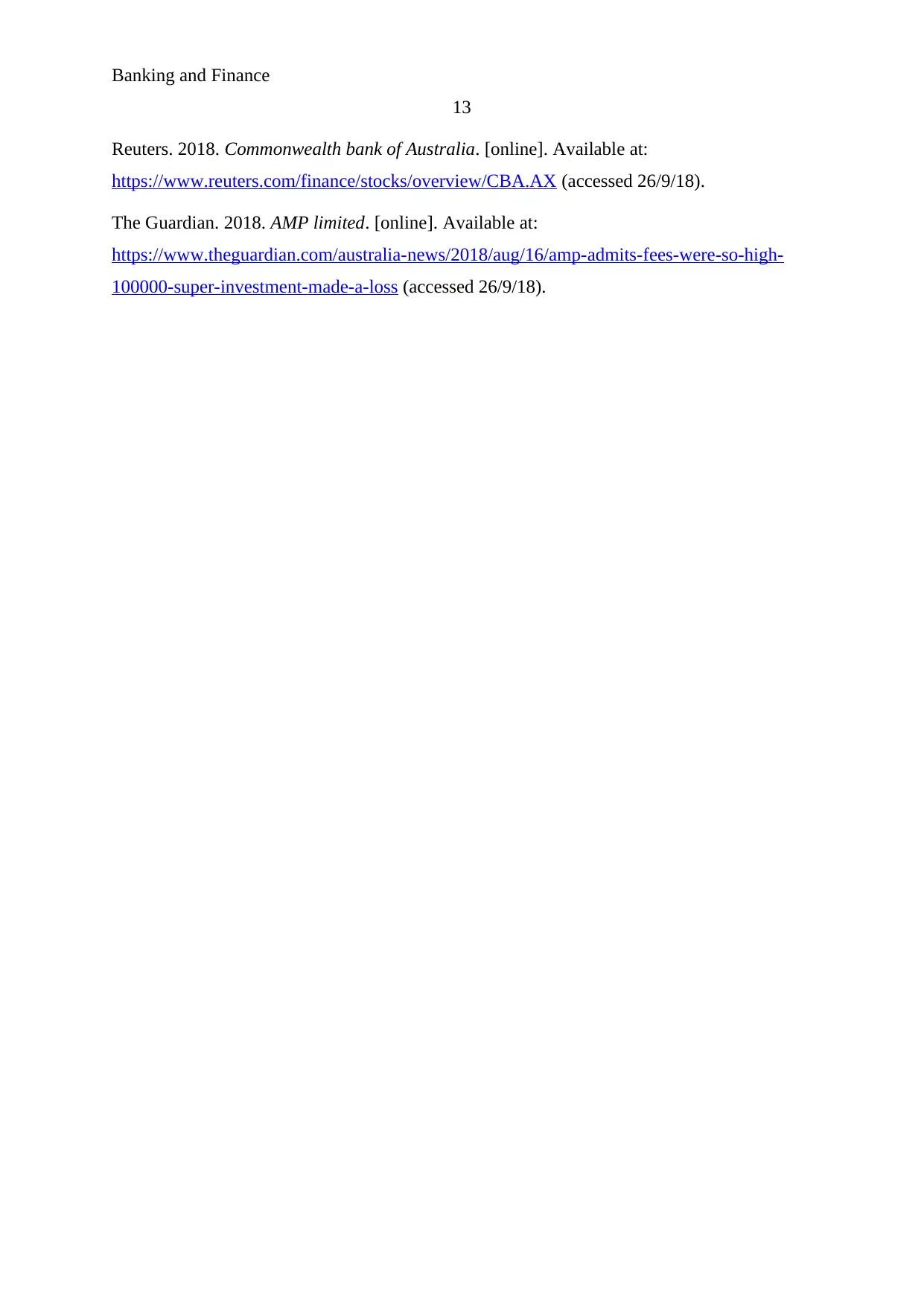
Banking and Finance
13
Reuters. 2018. Commonwealth bank of Australia. [online]. Available at:
https://www.reuters.com/finance/stocks/overview/CBA.AX (accessed 26/9/18).
The Guardian. 2018. AMP limited. [online]. Available at:
https://www.theguardian.com/australia-news/2018/aug/16/amp-admits-fees-were-so-high-
100000-super-investment-made-a-loss (accessed 26/9/18).
13
Reuters. 2018. Commonwealth bank of Australia. [online]. Available at:
https://www.reuters.com/finance/stocks/overview/CBA.AX (accessed 26/9/18).
The Guardian. 2018. AMP limited. [online]. Available at:
https://www.theguardian.com/australia-news/2018/aug/16/amp-admits-fees-were-so-high-
100000-super-investment-made-a-loss (accessed 26/9/18).
1 out of 13
Related Documents
Your All-in-One AI-Powered Toolkit for Academic Success.
+13062052269
info@desklib.com
Available 24*7 on WhatsApp / Email
![[object Object]](/_next/static/media/star-bottom.7253800d.svg)
Unlock your academic potential
© 2024 | Zucol Services PVT LTD | All rights reserved.





